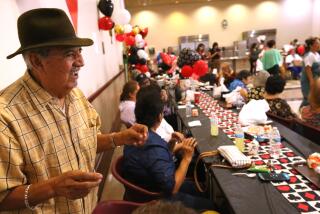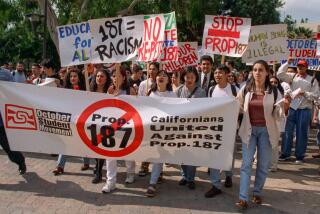Number of Hispanics, Asians Up on Westside : Census: Federal count shows Anglos still the largest group. Culver City is the only Westside municipality to show overall growth.
Westside cities showed a sharp increase in Hispanic and Asian residents over the last decade, according to data released this week by the U.S. Census Bureau.
But despite the waves of immigration that have changed the face of California since 1980, Anglos still dominate the populations of Beverly Hills, Culver City, Santa Monica and West Hollywood, the census found.
For the record:
12:00 a.m. March 3, 1991 For the Record
Los Angeles Times Sunday March 3, 1991 Home Edition Westside Part J Page 3 Column 1 Zones Desk 1 inches; 23 words Type of Material: Correction
Santa Monica mayor--An article in Thursday’s Westside section incorrectly identified City Councilman Dennis Zane as mayor of Santa Monica. Judy Abdo is the mayor.
The increase in Hispanics and Asians has been obvious, even without the census confirmation.
“I’m not surprised or upset. It’s pretty much the trend in California,” said Steven Gourley, mayor of Culver City, where the percentage of Anglos dropped by 10% while blacks increased by 27%, Asians shot up by 51% and Hispanics of all races showed a 19% upsurge.
Gourley doubted the Census Bureau’s total population figures, however, saying the reported 2% increase to 38,793 in Culver City was “hard to believe, given the growth and expansion that we’ve had on the Westside.”
Since state estimates over the last several years showed higher population totals, Westside cities stand to lose state and federal tax money if the federal count remains unchanged.
A number of cities, including Los Angeles, have filed suit against the Commerce Department, demanding that its totals be adjusted according to a formula intended to make up for undercounting of minority areas.
Culver City was the only one of the four Westside municipalities to show any growth over the last decade.
At 31,971, Beverly Hills experienced a negligible overall loss of about 300 people, but even in that high-priced enclave, the ethnic make-up of the population changed, albeit at a slower rate than the rest of the state.
With Anglos dropping in numbers by 5%, Asians more than doubled, to 1,708, while Hispanics boosted their numbers to 1,725, a 27% increase from 1980, and blacks showed a modest increase of 7%, for a total of 528.
“The fact that the population is flat doesn’t surprise me, because we are a mature community,” said Beverly Hills Mayor Allan L. Alexander. “That doesn’t strike me as showing any significant trend, other than a stable population because of the nature of the community.”
Although minority groups showed high percentages of growth, their numbers do not reflect any significant change in the ethnic make-up of Beverly Hills, where the Anglos are 87% of the population, blacks 2%, Asians 5% and Hispanics 5%.
The city’s growing Iranian-born population was counted in the Anglo category, a Census Bureau spokeswoman said.
In Santa Monica, a 9% increase in the number of dwelling units coincided with a 2% drop in population, something that Mayor Dennis Zane found hard to accept.
“Until we sit down and ferret out what it means, I don’t think anyone can respond with any confidence to these kinds of questions,” Zane said.
The 1990 Census found 86,905 in Santa Monica, three-fourths of them Anglos, 4% blacks, 6% Asians and 14% Hispanics. Asians had the sharpest increase, 56% since 1980, reaching a total of 5,385. Hispanics of all races totaled 12,210, 6% more than 10 years ago.
West Hollywood experienced a similar growth in housing units, increasing 8% to 23,821, while its population grew by a modest 1%, to 36,118.
West Hollywood saw increases of 44% for Asians and 57% for Hispanics during a decade when the black population declined by 9%. Total figures showed that Anglos made up 85% of the population last year.
The city, home to thousands of Soviet immigrant families, was the only one on the Westside to show an increase in the number of children under 18. The 2,557 youngsters represented 10% growth over 1980.
“This is certainly a trend the city feels good about,” said Mayor John Heilman. “We’ve been trying to create more day-care programs, to create a Head Start program for immigrant children.”
Although an appeal to the Census Bureau resulted in an increase in the city’s population total of about 1,000 over preliminary estimates, West Hollywood officials still feel that at least 1,500 residents were not counted, Heilman said.
“A large part of it is the language barrier. A large part of our residents are recent immigrants, and we believe that some of them do not understand the need to respond to the census, or are fearful or distrustful of government in general, because of where they’re from,” he said.
There was a 13% drop in the 18-and-under category in Santa Monica, a 10% drop in Beverly Hills and a 6% drop in Culver City, where the school district has closed schools at a time when Los Angeles schools have been forced to go on a year-round schedule.
Officials of all three cities noted that housing costs increased dramatically over the last 10 years, at the same time that the last of the baby boomers were leaving home and older couples made way for younger, two-income families who put off having children.
“It’s not a first-time home market for most people because of the high cost of housing,” Alexander said.
Although the number of blacks declined in the city of Los Angeles as a whole, blacks increased their numbers in the unincorporated residential enclaves of Ladera Heights and View Park-Windsor Hills, the data showed.
The Census Bureau report also indicated an 8% drop in the population of Marina del Rey, to 7,431.
Eric Bourdon, deputy director of Los Angeles County’s Department of Beaches and Harbors, which administers the marina, said he was surprised by the decrease. The marina’s apartments have a vacancy rate of 4%, he said.
ETHNIC/RACIAL DISTRIBUTION Following are the latest U.S. Census figures on the racial/ethnic population breakdown in Westside communities compared to the 1980 totals. In the data, the U.S. Census makes a distinction between racial groups and ethnic groups.
All categories except “Hispanic” are considered racial groups. The “Hispanic” category is considered an ethnic group and includes Hispanics of all races. Anglos are non-Hispanic whites.
All of the groups together represent the total population picture.
% Chg. % Chg. City Total from ’80 Anglo from ’80 Black Beverly Hills 31,971 -1 27,937 -5 528 Culver City 38,793 2 22,414 -10 3,881 Ladera Heights 6,316 -5 2,195 -37 3,596 Marina del Rey 7,431 -8 6,461 -12 301 Santa Monica 86,905 -2 65,184 -5 3,732 Vw. Pk.-Windsor Hills 11,769 -3 918 -37 10,185 West Hollywood 36,118 1 30,596 -2 1,155
% Chg. City from ’80 Beverly Hills 7 Culver City 27 Ladera Heights 38 Marina del Rey 2 Santa Monica 7 Vw. Pk.-Windsor Hills 2 West Hollywood -9
% Chg. % Chg. City Asian from ’80 Am.Ind. from ’80 Beverly Hills 1,708 122 42 55 Culver City 4,555 51 176 36 Ladera Heights 235 -17 12 -32 Marina del Rey 327 167 19 53 Santa Monica 5,385 56 270 -3 Vw. Pk.-Windsor Hills 176 -26 37 -10 West Hollywood 1,066 44 105 na
% Chg. % Chg. City Others from ’80 Hispanic from ’80 Beverly Hills 31 -89 1,725 27 Culver City 100 -78 7,667 19 Ladera Heights 38 -46 240 31 Marina del Rey 2 -97 321 22 Santa Monica 124 -89 12,210 6 Vw. Pk.-Windsor Hills 51 -54 402 38 West Hollywood 43 -88 3,153 57
Note: Percent changes for Asian and American Indian categories include Hispanics and non-Hispanics.
Source: U.S. Bureau of the Census ETHNIC GROUPS
City Anglo Black Asian Am.Ind. Other Hispanic Beverly Hills 87.4% 1.7% 5.3% 0.1% 0.1% 5.4% Culver City 57.8% 10.0% 11.7% 0.5% 0.3% 19.8% Ladera Heights 34.8% 56.9% 3.7% 0.2% 0.6% 3.8% Marina del Rey 86.9% 4.1% 4.4% 0.3% 0.0% 4.3% Santa Monica 75.0% 4.3% 6.2% 0.3% 0.1% 14.0% View Pk.-Windsor Hills 7.8% 86.5% 1.5% 0.3% 0.4% 3.4% West Hollywood 84.7% 3.2% 3.0% 0.3% 0.1% 8.7%
Source: U.S. Bureau of the Census POPULATION AND HOUSING
% Chg. % Chg. City Adult from ’80 Children from ’80 Beverly Hills 26,677 1 5,294 -10 Culver City 31,548 4 7,245 -6 Ladera Heights 5,232 -2 1,084 -17 Marina del Rey 7,115 -10 316 101 Santa Monica 74,928 0 11,977 -13 View Pk.-Windsor Hills 9,700 3 2,069 -23 West Hollywood 33,561 1 2,557 10
% Chg. % Chg. City Dwellings from ’80 Per dwelling from ’80 Beverly Hills 15,723 6 2.0 -7 Culver City 16,943 6 2.3 -4 Ladera Heights 2,677 4 2.4 -9 Marina del Rey 5,419 -4 1.4 -4 Santa Monica 47,753 9 1.8 -10 View Pk.-Windsor Hills 4,749 4 2.5 -6 West Hollywood 23,821 8 1.5 -6
Source: U.S. Bureau of the Census
More to Read
Sign up for Essential California
The most important California stories and recommendations in your inbox every morning.
You may occasionally receive promotional content from the Los Angeles Times.










